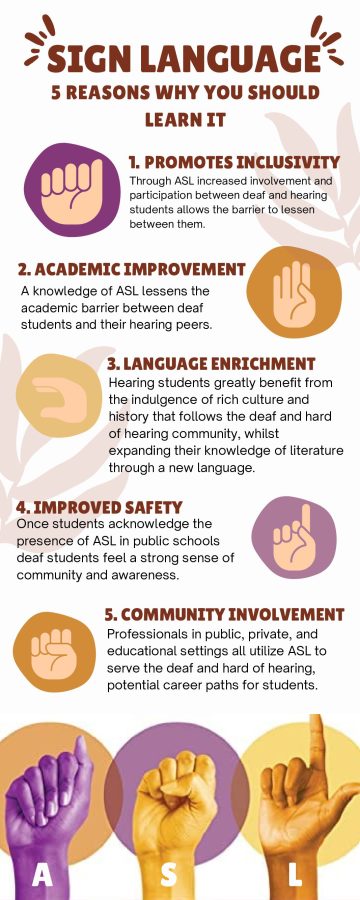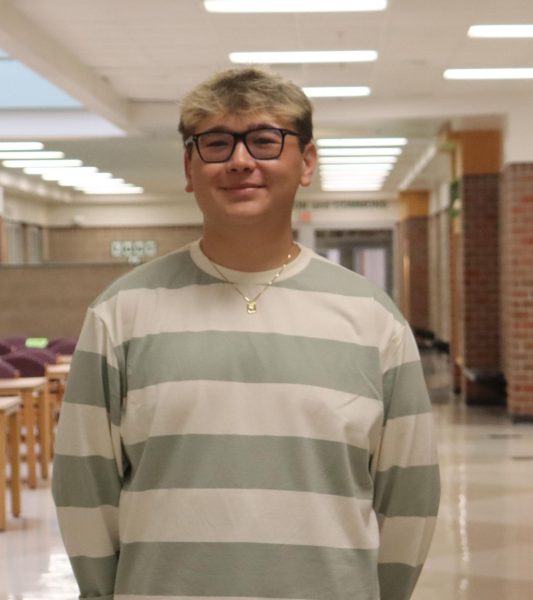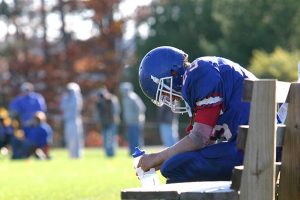Saving sign language
Public schools lack deaf representation
Sign Language, often unrecognized by public schooling institutions, despite being utilized by over 500,000 people in the United States, desperately needs to be implemented into high school world language curriculums.
January 17, 2023
Spanish, French and German; the three most prevalent languages taught in high schools throughout the United States, however one significant language is overlooked: sign language. Taught in over 1,000 schools across America because of the rich literacy and language enrichment it provides, Sign Language has proven to be a necessity in every world language cirriculum.
Despite ASL being the fifth-most used language in the United States, it is scarcely adopted in public schooling institutions. And considering its benefits it is vital these schools acknowledge the presence of ASL and adopt it in their world language curriculums.
Teaching sign language at the high school level can provide lifelong benefits such as improved literacy of the students’ spoken language as well as enhanced appreciation for diversity within academic communities composed of deaf, hard of hearing, and hearing individuals. By implementing an ASL course students would not only have the ability to spread their knowledge across a new language, but also help improve the safety and comfortability of students whose only form of communication is through sign language.
Not only would the addition of an ASL course promote inclusivity for deaf students at school, but also further help lessen the academic barrier that exists between deaf students and their hearing peers. According to the American Sign Language Teacher Association, results from numerous studies have indicated that deaf children have significantly poorer reading comprehension, literacy skills, and overall depressed academic achievement in general when compared to their hearing peers. When hearing students develop an acquisition of ASL and higher levels of ASL proficiency it benefits the reading skills of deaf signing kids because of the equal learning opportunity it promotes amongst students.
Being proficient in ASL allows improved communication with a wide range of hearing, hard of hearing, and deaf individuals, not just including students, but also deaf residents and business people in your community. Students would not only be able to utilize their sign language skills in high school, but also continue them through their decided career path. Professionals in public and private agencies and educational settings—such as teachers, counselors, consultants, therapists, and specialists use ASL to serve the deaf and hard of hearing. Law enforcement and emergency response workers also benefit from a knowledge of ASL.
Just as Spanish, French, and German courses help enrich students in language and culture, American Sign Language does the same. Both inside and outside of the classroom, students can use the material and apply it to real world situations, in addition to fostering a better sense of community for a group of underrepresented individuals.
Considering the benefits, its vital public schools acknowledge the presence of sign language in their institutions. Because of the inclusivity and awareness it promotes, American Sign Language should be implemented in world language curriculums across the United States. American Sign Language education also enhances the academic achievement of deaf and hard of hearing students, whilst developing equality amongst their hearing peers. Just imagine taking a few steps in their shoes. They are not foreigners or outcasts; these are people who are being forced to be seen as separate from society. The real problem is a language barrier, which has stifled progress despite a simple solution: allow students to learn this language so that the deaf and hearing-impaired community does not feel so isolated amongst their peers.







